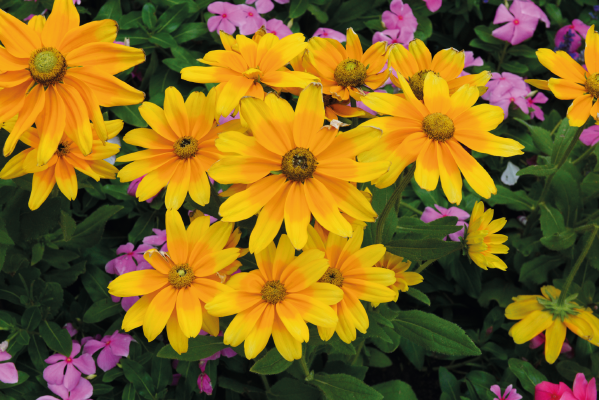

Prairie Sun
Item no.: RH0401P- FleuroSelect Gold Medal and AAS award winner
- Brilliant golden-yellow flowers with stunning green eye
- Huge flowers on sturdy stems hold up to weather
- Vigorous sister of Amarillo Gold
Technical Guide: Click here
All information in our technical guide is based on our own trials and would therefore be as guideline only. Detailed cultivation aspects vary depending on climate, location, time of year and environmental conditions. Benary expressly disclaims any responsibility for the content of such data/information and makes no representation or warranty for the cultivation of any products listed. It is recommended that growers conduct a trial of products under their own conditions.
- Crop Time
- Spring: 15 - 18 weeks , Summer: 13 - 15 weeks
- Height ∅
- 30 ″ / 75 cm
- Flower Size ∅
- 6 ″ / 15 cm
- Exposure
- Sun
- Seed Form
- BeGreen Pelleting
- Best Uses
- Bedding, Landscape, Cutflower
Culture guide
Usage
Plants for border, pot and container plants, cut flower production
Sow time
November for flowering in pots from April onwards; April for flowering in pots from June onwards
Sowing method
2-3 seeds per plug, can be sown directly into final pot
Germination
8-14 days at 68-72 °F (20-22 °C)
Growing on
Transplant plugs into 4.5" (11 cm) or larger pots. Grow on at 60-64 °F (15-18 °C) day temperatures and 50-55 °F (10-13 °C) night temperatures. Feed weekly at 150 ppm nitrogen in a well balanced fertilizer mix.
Lighting: Requires a minimum day length of 14 hours to initiate flowering. Plants that do not receive sufficient day length will form rosettes and flowering will be delayed. Day length extension of greater than 16 hours can cause stem elongation. Light manipulation can be used to control plant growth.
Media
Use a well-drained, growing substrate with 20-30 % clay, 1-1,5 kg/m³ complete balanced fertilizer, 0-2 kg/m³ slow release fertilizer (3-6 months), iron-chelate, micronutrients, pH: 5.8-6.2. Field: loamy sandy to sandy humus soils with good drainage and good nutrition levels. Standard fertilization: 80-100 g/m² of a slow release fertilizer.
Temperature
Grow at 18-20 °C. R. hirta needs warm temperatures for the growth. Temperatures of 16 °C increase the cultivation time by 3 weeks. Temperatures below 16 °C can be a cause for red colouring of leaves. R. hirta does not tolerate frost.
Fertilization
Moderate fertilization levels are required. Fertilize the crop weekly with 100-150 ppm nitrogen (at 0 kg/m³ slow release fertilizer in substrate), using a potassium balanced fertilizer (N: K₂O-ratio: 1:1,5). Avoid high ammonium and high nitrogen levels. Prevent magnesium deficiency by applying magnesium sulphate (0,05 %) 1-2 times and in case of iron deficiency (above pH 6.0) apply iron-chelate for 1-2 times. Field: Take care of possible iron deficiency and apply iron-chelate for 1-2 times. N min soil value: approximately 130 g N/m².
Stage I Starts with the radicle breaking through the testa. The roots are touching the medium. Ends with fully developed cotyledons.
Stage II Starts from fully developed cotyledons. Ends with the fully developed true leaf or true leaf pair.
Stage III Starts from the fully developed true leaf or true leaf pair and ends with 80% of the young plants being marketable.
Stage IV All young plants are ready for sale and in the process of being hardened off. This stage lasts about 7 days.
The cultural recommendations are based on results from trials conducted under Central European conditions. Different conditions in other parts of the world may lead to deviations in results achieved.




